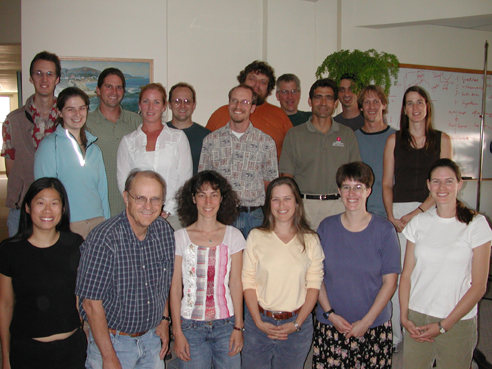NCEAS Working Groups
Comparing trophic structure across ecosystems
Project Description
Trophic structure, the partitioning of biomass among organisms at different positions in a food web, varies both within and among ecosystems. However, the causes of this variation are poorly understood. Elton's "pyramid of numbers", where primary producers dominate and consumer densities decrease as trophic levels become more remote from the base of production, applies well to most terrestrial systems. However, many aquatic ecosystems apparently violate Elton's rule with inverted biomass pyramids, or ratios of heterotroph-to-autotroph biomass (H:A) greater than one. In this proposal, we describe synthetic work aimed at understanding differences in trophic structure and the relative strength of bottom-up and top-down inputs between diverse freshwater, marine and terrestrial ecosystems. We will test candidate hypotheses for this variation based on factors known to distinguish food webs in the two habitats, such as nutrient limitation and turnover rates, productivity (quantity) and nutrient stoichiometry (quality). Meta-analysis of local-scale herbivore manipulation experiments will be integrated with theoretical development of food web models, and with larger-scale temporal and spatial patterns from resource gradients. This work will move us closer to a comprehensive trophic-dynamic theory, unified across taxa and ecosystem types. It will also increase our mechanistic understanding of how human impacts, such as eutrophication or predator extirpation, propagate or attenuate in ecosystems through trophic interactions.

Principal Investigator(s)
Jonathan B. Shurin, Daniel S. Gruner, Helmut Hillebrand
Project Dates
Start: October 3, 2005
End: November 6, 2006
completed
Participants
- Elizabeth T. Borer
- Oregon State University
- Matthew E. Bracken
- University of California, Davis
- Bradley J. Cardinale
- University of California, Santa Barbara
- Just Cebrian
- University of South Alabama
- Elsa E. Cleland
- University of California, Santa Barbara
- Kathryn L. Cottingham
- Dartmouth College
- Claire de Mazancourt
- Imperial College, London, Silwood Park Campus
- James J. Elser
- Arizona State University
- Daniel S. Gruner
- University of California, Davis
- W. Stanley Harpole
- University of California, Irvine
- Helmut Hillebrand
- University of Cologne
- Jacqueline T. Ngai
- University of British Columbia
- Stuart A. Sandin
- University of California, San Diego
- Eric W. Seabloom
- Oregon State University
- Jonathan B. Shurin
- University of British Columbia
- Jennifer E. Smith
- University of California, Santa Barbara
- Melinda D. Smith
- Yale University
- Donald R. Strong
- University of California, Davis
- Elizabeth M. Wolkovich
- Dartmouth College
Products
-
Book Chapter / 2009
Top-down and bottom-up regulation of communities
-
Presentations / 2009
Why is the world green? Examining the independent and interactive roles of nutrients and consumers
-
Journal Article / 2013
Global biogeography of autotroph chemistry: Is insolation a driving force?
-
Journal Article / 2015
Signatures of nutrient limitation and co-limitation: Responses of autotroph internal nutrient concentrations to nitrogen and phosphorus additions
-
Journal Article / 2009
Separating the influence of resource 'availability' from resource 'imbalance' on productivity-diversity relationships
-
Presentations / 2007
Producer control of aquatic-terrestrial contrasts in trophic structure
-
Journal Article / 2009
Producer nutritional quality controls ecosystem trophic structure
-
Data Set / 2009
Producer nutritional quality controls ecosystem trophic structure
-
Journal Article / 2010
Nitrogen enrichment and plant communities
-
Presentations / 2009
Carbon exudation as a cross-ecosystem phenomenon: Magnitudes, causes and consequences
-
Data Set / 2007
Global analysis of nitrogen and phosphorus limitation
-
Journal Article / 2007
Global analysis of nitrogen and phosphorus limitation of primary producers in freshwater, marine and terrestrial ecosystems
-
Presentations / 2009
Global patterns of nutrient limitation and effects of anthropogenic N deposition
-
Journal Article / 2010
Plant water use affects competition for nitrogen: Why drought favors invasive species in California
-
Data Set / 2006
Experimental manipulations of nutrients and trophic structure across ecosystems
-
Journal Article / 2008
A cross-system synthesis of consumer and nutrient resource control on producer biomass
-
Data Set / 2008
Cross-system synthesis of consumer and nutrient resource control on producer biomass
-
Presentations / 2009
Top-down and bottom-up control of primary production across ecosystems
-
Data Set /
Cross-system synthesis of consumer and nutrient resource control on producer biomass
-
Journal Article / 2007
Grassland species loss resulting from reduced niche dimension
-
Presentations / 2009
Multiple resource limitation across ecosystems
-
Journal Article / 2011
Nutrient co-limitation of primary producer communities
-
Journal Article / 2007
Consumer versus resource control of producer diversity depends on ecosystem type and producer community structure
-
Presentations / 2009
Control of producer diversity across ecosystems in a changing world
-
Journal Article / 2009
Herbivore metabolism and stoichiometry each constrain herbivory at different organizational scales across ecosystems
-
Journal Article / 2012
Grassland community composition drives small-scale spatial patterns in soil properties and processes
-
Journal Article / 2006
All wet or dried up? Real differences between aquatic and terrestrial food webs
-
Presentations / 2009
Trophic structure differences across ecosystems
-
Presentations / 2007
How coupling between green and brown food webs alters trophic structure: A modeling perspective
-
Presentations / 2009
C- exudation as a cross-ecosystems phenomenon: Magnitudes, causes, & consequences
-
Journal Article / 2014
Linking the green and brown worlds: The prevalence and effect of multichannel feeding in food webs
